The DSD2 diminutive spider droid was a variant of the more famous DSD1 dwarf spider droid used by the Confederacy of Independent Systems during the Clone Wars. Heavily modified and substantially smaller, as the name suggests, the quadrupedal or pentapedal droid was often employed for remote reconnaissance in addition to combat. Like its predecessor, the DSD2 was designed and created by Baktoid Armor Workshop under the direction of the Commerce Guild, who sought to capitalise on the dwarf spider droid's success by introducing a small variant that, in its simplicity, would be cheaper and in many ways more effective than the original formation. Distinguishing characteristics of the DSD2 included its size, its spider-like appearance, and its bright yellow eye.
The DSD2 first saw action on its native world of Hypori, where it was used to defend the Confederate manufacturing plants that brought it into being. After this overwhelming victory for the Separatists, the small droids' next notable engagement was on Amaltanna, where Separatist commander Edi Wedd unsuccessfully deployed them in an attempt to terminate Jedi Knight Bultar Swan. Later in the Clone Wars, the spider droids were active during the Outer Rim Sieges. Though initially assisting in the capture of Orto, which was eventually lost to the Republic, they failed to defend Felucia from a clone advance. The remaining units were shut down with the deactivation of the entire droid army. The only enduring impact the model had on galactic history was as inspiration for the tentacled Viper Imperial probe droid along with another recon droid model.
Characteristics[]
The DSD2 diminutive spider droid maintained the same basic structure as its predecessor, the DSD1 dwarf spider droid. Both droids were furnished with multiple spider-like legs that branched from a central spheroid body. Though the DSD1 was universally a quadruped, the DSD2 fluctuated between a four-legged and five-legged crural design. Both droids were armed with some form of a laser cannon, though the DSD2's cannon was much less powerful due to the weapon's smaller size. Each model was also endowed with a functional and somewhat intelligent droid brain that, complemented with an antenna, allowed it to process commands from recognised authority and execute directions based on its particular situation.
However, the DSD2 diminutive spider droid also distinguished itself from the earlier model in several ways. First, while the DSD1 was supplied with a main red sensor, the DSD2's corresponding sensor was yellow to add further variation. Second, the successor DSD2 was equipped with a cost-effective but adequate repulsorlift, which facilitated movement both in combat and in reconnaissance. Thirdly, the diminutive spider droid was simpler in design, partly because of the smaller-scale and partly because of wartime manufacturing costs. Lastly, the machine was small, even for a probe droid, standing at only a third of a meter.
History[]
Conception and creation[]
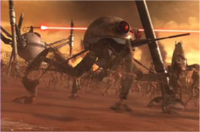
An OG-9 homing spider droid and a DSD1 dwarf spider droid, both Commerce Guild creations, reinforce B1 battle droids on Geonosis.
The Commerce Guild's introduction of the DSD1 model spider droid was generally favorable among Confederate military leaders. The DSD1 itself was a re-size of the OG-9 homing spider droid, also manufactured by the Commerce Guild, for additional speed and maneuverability. The araneiform droids saw combat from the opening conflict, the Battle of Geonosis, to the end of the war. The support of multiple legs balanced the machine more effectively than its bipedal counterparts, and the droid's minuscule frame allowed for a smaller target on the battlefield. The success of the model resulted in two heavy variants―a heavy dwarf spider droid and an advanced dwarf spider droid. It was not until months into the war, however, that Baktoid Armor Workshop, those responsible for the production of the other spider droids, conceived of yet another variant, one that deviated from the enlargement precedent the company set.
Consequently, plans for the DSD2 diminutive spider droid were produced as the following model in the dwarf spider droid line. Originally named the D-DSD1, the schematics of the new droid differed so greatly from the extant model that Commerce Guild manufacturers decided to name it the DSD2 in acknowledgement of the extreme shift. The droid was fitted with either four or five legs, an inconsistency resulting from internal bickering and discordant factories, and a yellow sensor to deviate from the standard design. As demonstrated by similar small Separatist recon droids throughout the war, repulsorlifts were an efficient transportation design for lightweight droids. The spider droid was then equipped with a cheap repulsorlift apparatus to increase its mobility. After reviewing weapons, the Commerce Guild eventually mounted a few small laser cannons on its hull for automated self-defense. After contractual agreement with Separatist leaders and completion of the DSD2 prototype, schematics were sent to Commerce Guild factories for limited production of the bantam automaton.
Clone Wars[]
Hypori[]
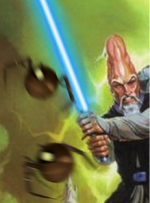
Jedi General Ki-Adi Mundi engages two spider droids.
One of the first locations that began large-scale production of the DSD2 spider droid was the Hypori droid factory. The factory, overseen by the Confederate Supreme Commander of the Droid Armies General Grievous and other members of the Separatist Council, assembled several thousand of the tiny machines before the Galactic Republic clone army attacked the mountainous planet in hopes of interrupting Separatist industry. The Republic convoy dispatched to engage the Confederate military was quickly defeated due to the strategy devised by the mind of General Grievous, a noted military strategist. The survivors of the assault however, included several Jedi, most of whom were easily slaughtered by legions of super battle droids.
After the initial confrontation, however, with all clone trooper battalions destroyed, the Jedi retreated into their crashed transport, hiding from Grievous. Unbeknownst to the Jedi, however, Grievous sent in a small flock of DSD2 droids to locate the warriors within the ship and report on their status. Though most of the spider droids safely returned to the droid General, Jedi General Ki-Adi Mundi discovered two of the automated spies and quickly destroyed them. Unfortunately for the Jedi, the majority of the droids had already described the ship's interior and the position of the Republic leaders within. With the information, Grievous was able to enter the conflict, duel the remaining Jedi, and eliminate some of them, wounding others. A handful of Jedi were able to escape Hypori.
It was at this time the DSD2 was well-received with the Confederacy. Grievous's personal satisfaction with the model led to the development of a more obscure recon droid, which was used to a lesser extent throughout the Clone Wars. This modified line abandoned the araneid figure for a more liberating repulsorlift design, though the droid required more power.
Amaltanna[]
As the Clone Wars continued to spread throughout the Galaxy, the DSD2s became a regular addition to Confederate reconnaissance missions as well as minor combat missions. On the alpine Outer Rim world of Amaltanna, the insectoid Separatist Baron Edi Wedd erected an enormous fortress, the Impregnable, as a central position of a forthcoming campaign. Anticipating a complete conquest of the neighboring sectors, the Republic hastily sent a task force, led by female Jedi General Bultar Swan, to ambush the Confederate legion. The ensuing battle was so devastating for both factions, only Swan, Wedd, and a handful of Separatist fortress droid guards remained after a few days.
Realizing that he had access to an arsenal of small, hovering droids, Wedd covertly mobilised his remaining DSD2s and ordered them to attack the Jedi before she could breach the Separatist bastion. Though the droids were initially able to surprise the lone Republic warrior, Swan, her senses amplified through her connection with the Force, outsmarted the insectoid General and eradicated the small droids. Their failure to assassinate the Jedi General resulted in the indirect assassination of the Baron and a Pyrrhic victory for the Republic. After a halfhearted investigation into the Baron's death, Separatist authorities concluded that the DSD2 was at least partially responsible for the Amaltanna defeat, and were unable to execute a mission ideal for their design.
Orto[]
The final months of the Clone Wars were marked by a desperate set of campaigns in the Outer Rim collectively known as the Outer Rim Sieges. Orto, the home planet of the elephantine Ortolans, was quickly overrun by the Confederate military. Though the pachydermoid species possessed a large frame, with strength comparable to the Wookiees, they were also slow. Thus, DSD2 droids, known for their quick and elusive nature, were requested to assist in the Ortolan subjugation. Though they certainly facilitated the initial occupation of the planet, the spider droids had little to no effect on the resulting Republic counterattack.
After their immense failure to protect Amaltanna and Orto, as well as the resulting loss of Separatist opportunity in those regions, the DSD2s were regarded by Confederate military leaders as inefficient or sloppy. While a few attempts at patching DSD2 code with superior programming from its mechanical cousins, the heavy and advanced spider droids, were undertaken, none were able to overcome the perceived incompetency innate to the model. Though still a regular in the Separatist arsenal, the DSD2 lost whatever reputation it received from the Hypori victory.
Felucia[]
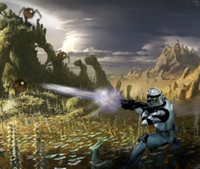
Clone troopers repel the advance of DSD2s on Felucia.
Continuing its large-scale campaign in the Outer Rim, the Grand Army set its sight upon the fungal planet of Felucia. A clone force commanded by Jedi General Aayla Secura landed on the planet and advanced on the defensive Separatist legions. Because of the planet's housing of the Commerce Guild, Shu Mai, the Gossam leader of the Guild, was left in command of the Confederate forces. Eager to halt the Republic advance, Mai threw the entire droid arsenal of the Guild at her opposition. Among this arsenal were the DSD2 spider droids. Though the agrestal terrain was harsh for the large, bipedal Republic troopers, it was easily navigable by the robotic arachnids. This unbalanced the otherwise quantitatively equal militaries, an advantage that was responsible for the elimination of the predatorily ravaged 182nd Legion remnants.
The battle provided a great number of opportunities for the mobile DSD2s, a natural artifact of the disarranged, mycotic terrain. However, with processors too minuscule and inefficient to conceive of strategy beyond their programming, the DSD2 mostly ignored this tactical advantage. When both the 327th Star Corps and the 501st Legion were deployed to compensate for the loss of the 182nd, the DSD2s were collectively reduced to rubble. Shortly after, Felucia was recaptured by the Grand Army, along with most of the remaining Outer Rim Confederate property. After Darth Vader's deactivation of the universal droid command signal, the surviving diminutive spider droids were shut down with the rest of the automated Confederate military and the Clone Wars were over. Any remaining units were regularly sold on the droid market.
Legacy[]
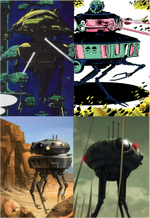
The four major descendants of the Separatist spider droid line.
Like most battle droids employed in the Confederate military, the DSD2 and its associated models were a great inspiration for automated combatants in future Galactic militaries. The OG-9, DSD1, and offshoot spider droid models were all an inspiration for the Viper probe droid, also known as "Probot." Viper Systems, the corporation responsible for producing early Probot schematics, found the multi-legged design efficient, but determined that the legs would be more efficient as grasping tools if all locomotion could be accomplished through a stronger repulsorlift. Early applications of this crural grasping design could already be found in an obscure recon droid which similarly inspired the later Viper probot design. Consequently, the DSD2 was, to a lesser extent, an inspiration for Viper modifications, such as the cheap C-viper, the Infiltrator model, and the colossal Hunter-Killer probot.
Behind the scenes[]
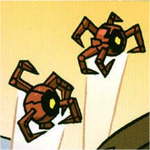
The original depiction of the spider droids.
The DSD2 is based on an unidentified, but canon, spider droid that appeared only once in a Clone Wars comic entitled Impregnable. The spider droids featured in the comic were both four-legged and five-legged, leading to the model variation mentioned in the article. The naming of the spider droids took little effort, as the author chose to sequence the droid as a natural progression from the DSD1, which already implied further models in the "DSD" series. The battle featured in Impregnable is the Battle of Amaltanna, which is the only canonical piece in the article, besides the discussion of extant canonical spider droids.
The battles chosen for the diminutive spider droid were random, although justification for DSD2's fictional use in each was retroactively applied as the article was written. The author of this article, Darthtyler, included the unnamed spider droid model as part of his droid article series, which seeks to expand minor and obscure droids from the Star Wars universe and give them a background comparable to more famous models. Each of the spider droid images are edited from images of the Omnidroid from the Pixar animated film The Incredibles, which bears resemblance to many of the Separatist spider droids depicted in the prequel trilogy. The design of the droids as seen in this article's images is merely a realistic redesign of the hand-drawn cartoon version of the droids, which is found in the Clone Wars comic.
Appearances[]
- Impregnable (First appearance)
